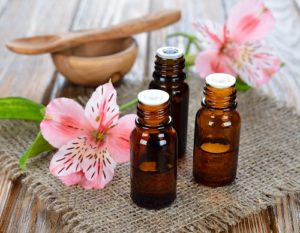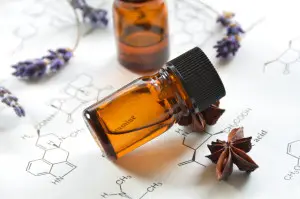Can essential oils be used for cooking and general consumption? In short, the answer is yes – that is, if you use a trusted brand and the right kind of oil.
Organic food grade essential oils can both complement your recipes and be an effective method when applying internally. Just be sure to read the label on the product and research the brand before you consume the product.
 So what are food grade oils?
So what are food grade oils?
Essentially (no pun intended), food grade oils are suitable natural products that can be used for flavoring while also being safe for consumption. Applied sparingly, these potent natural solutions can add strong flavor and scent to foods such as soups, marinades, candies, and baked goods.
Therapeutic grade essential oils are highly concentrated, authentic derivatives of various plants. In addition to being used for their aromatic qualities, they can also be used to enhance your recipes. Here are just a few examples of how you can use essential oils in your food:
- Lemon, orange, and peppermint are great for candies and desserts
- Thyme and Marjoram work well with savory foods like sauces and soups
- Bergamot and lavender are commonly used for sweets like chocolate
[amazon box=”B01161IL20″]
It certainly depends on who you talk to, but as long as you’re using the right product, essential oils can in fact be ingested. And depending on the intended use, there are many benefits to this application method. For example, the Digestive Blend is highly effective at easing stomach problems when taken internally.
Related articles:
 That being said, you still want to be careful in how you apply them and who you are applying them to. First off, before applying essential oils to your child, be sure to diligently research the brand and specific oil you intend to use. Even if you are using a quality, 100% pure and organic oil, you’ll want to not only read the product label, but learn more about the particular oil you plan on using.
That being said, you still want to be careful in how you apply them and who you are applying them to. First off, before applying essential oils to your child, be sure to diligently research the brand and specific oil you intend to use. Even if you are using a quality, 100% pure and organic oil, you’ll want to not only read the product label, but learn more about the particular oil you plan on using.
How to use food grade essential oils
[amazon box=”B071RXT6N8″]
There are numerous ways to use food grade essential oils. First, here are some tips on using them in savory cooking:
- For a good majority of oils, a single drop can replace a teaspoon of spice or herb.
- For a bold taste, use oils like oregano, marjoram, rosemary, and thyme.
- You can simmer bold-flavored oils in soups to deliver a milder flavor.
Food grade essential oils are great for use in chocolate, and there are a number of recipes out there to consider. When crafting chocolate or other candies, consider these tips:
- Use about ¼ to ½ teaspoons per pound of chocolate.
- Add essential oil to melted chocolate and stir up to a smooth mixture.
- When adding floral products like lavender or bergamot, only a small portion of the oil is needed.
- Start with a smaller amount and increase as needed.
They are natural, you know
In case you’re wondering how they work – and why most are safe for internal consumption – essential oils are natural compounds of plants. They can be found in a range of different plants, including everything from seeds to roots to stems and flowers.
Contrary to what some believe, essential oils are not synonymous with perfume or other chemically-infused fragrances. While they emit aromatic characteristics, essential oils (at least, the right kind) are not manufactured artificially with chemicals. Many perfumes include artificial compounds which don’t provide any form of therapeutic benefit.
Not all oils are created equal
That’s right. The brand and manufacturer’s method of production plays a critical role in the quality of the oil. We recommend only therapeutic food grade essential oils, especially when you’re considering them for internal use.
There are some oils that have the potential to cause irritation, whether it be on your skin or elsewhere. That’s why you want to choose a quality product that is both safe and effective.
[amazon box=”B0128HRZOG”]


Hello,
Can frankincense be taken orally? How about rosemary, chamomile, oregano and thyme essential oils? Are they safe taken orally?
Thank you
What essential oil brand would you recommend that is classified as a good grade organic essential oil?
Hello,
What method of production is safe for oral consumption? What questions should I be asking about essential oils – when purchasing for oral consumption – purely for flavour and aroma?
Is there a food grade eucalyptus oil?
Hello,
Thanks for the question. Personally, we haven’t come across a eucalyptus oil that is food grade. I would be surprised if it was recommended by any companies. doTerra seems to offer the most food grade products and they even recommend against it.
Brian
I will send you a list of Essential Oils and would you be able to supply Food Grade Certification for the list of Essential oils I will send you?
Having the Food Chemical Codex information for each oil and % of Methyl Eugenol in each oil.
Rosemary EO
Lavender EO
Canola Carrier oil
Capsicum Oleoresin
Garlic EO
Juniper Berry EO
Rosemary Oleoresin
Rosemary EO
Cassia EO
Mint EO
Spearmint EO
Geranium EO
Peppermint EO
White Pepper EO
Clove EO
Catnip EO
Cedar EO
Black Pepper EO
Vegetable Glycerine
Ginger Oleoresin
Ginger EO
Eucalyptus EO
Lemon Eucalyptus EO
Thyme EO
Basil EO
Lemon EO
Lemongrass EO C
Citronella EO
Grapefruit EO
Clary Sage EO
Cumin Seed EO
Tumeric Root EO
Curcumin EO